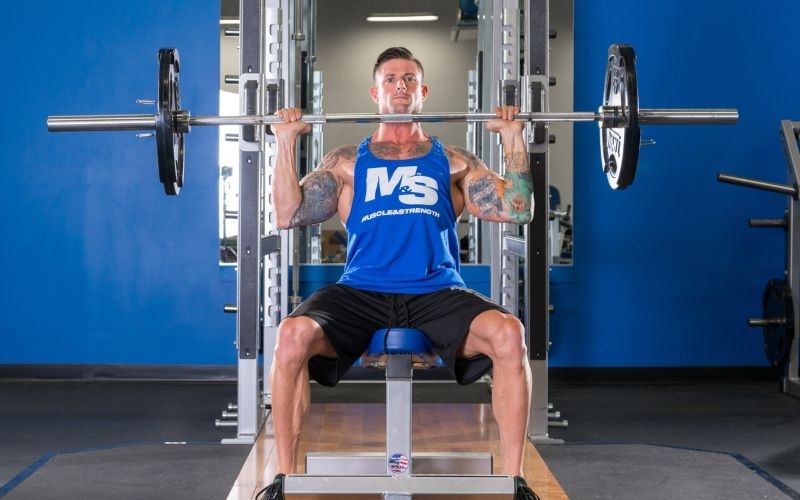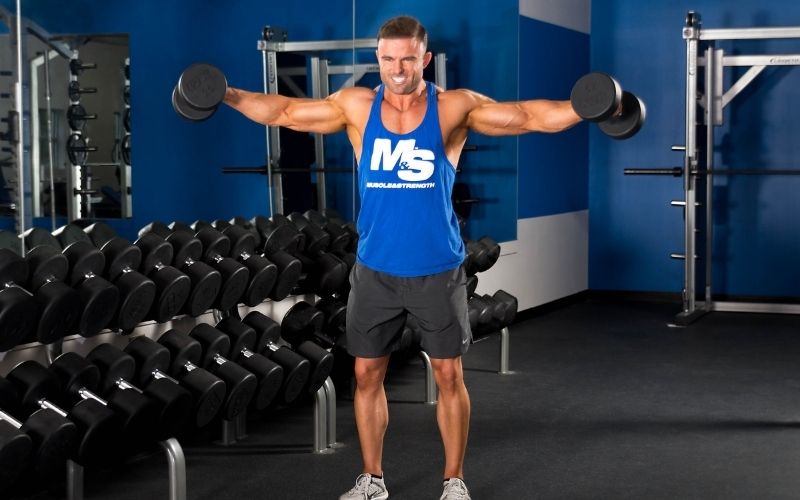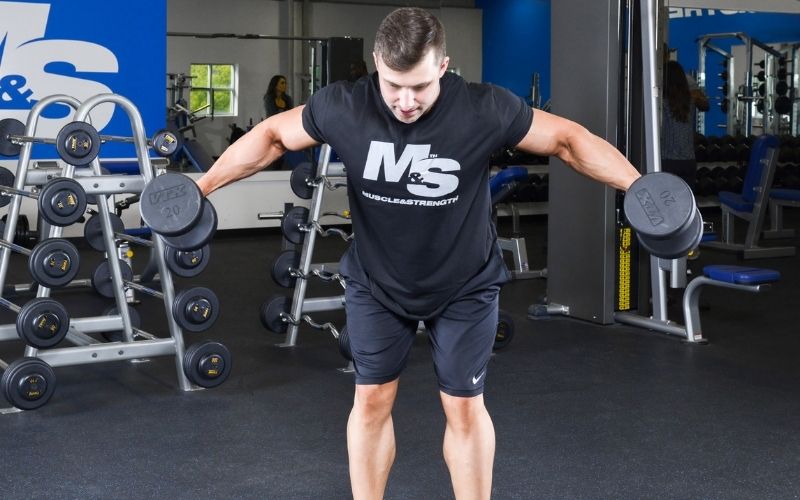01dragonslayer
Ripped
- Jacked Cash
- 486,641
Workout Description
Everyone that has been training for a while remembers what it was like to be a beginner learning the ropes of working out.If you're one of those iron veterans, then you may also remember the feeling of uneasiness as you took the training wheels off to try some of the more advanced tips and tricks that you saw those big dudes doing.
Some of you reading this may be in that position now.
You’ve been training for a few months, saw some great progress, and now you feel you’re ready to step up your game. Are you sure you’re ready to leave the days as a beginner behind?
If so, then this workout can be the litmus test for you.
This shoulder workout will still feature basic moves because, at the end of the day, basics can still be best. However, there will be a unique twist on each of them. Below is a brief description of how each exercise should be performed.
Follow this routine once every 5-7 days for eight weeks, and watch those shoulders grow.
Let's get to work.
Related: The Complete Guide To Growing Big Shoulders!
The Exercises
Seated Barbell Press – 1 ½ Reps
We’re going to start with a classic movement that will help you get bigger and stronger delts. The basic barbell press allows you to use more weight and push one object with both sides of your body. Lowering the bar as far down as possible before pressing back up is as simple as it gets. Here’s where the twist comes in.Doing one and a half reps is exactly as it appears to be. You follow up a whole rep by doing a half rep, but you only count it as one. So, imagine yourself on a seated bench with the barbell in your hands. You would lower the bar down to the shoulders, but only press it half way up before returning to the bottom. Then, you press up.

By doing this, you’re contracting the front delts twice, but you only count it as one rep. The result is more work and greater results for the front head of the shoulders. You may also notice a strength increase by using this strategy.
If you have bad shoulders and feel more comfortable doing it on a machine, go for it. Home gym people with dumbbells, you can do this as well.
Front Raise – Long Pause at the Top
The front raise is a great exercise to isolate the front head of the delt. The only downside to it is that sometimes, lifters use momentum instead of concentrating on making the muscle work. This hack fixes that.This can be done with a barbell, dumbbells, kettlebells, or a cable with the appropriate handle. Perform the raise up to shoulder height, but don’t let the resistance drop. Hold it at the top for a count of three before lowering it back down under control. On the final rep of each set, hold the weight at the top for as long as possible.
Once you reach failure, that set is over. Repeat this for three sets, and those front delts will feel the burn for sure.

Lateral Raises – Left, Right, Both
When it comes to the side head of the deltoid, nothing beats the lateral raise. So, if it isn’t broke, don’t fix it. That doesn’t mean we can’t give this movement an upgrade.Some folks may have trouble feeling the side delts working with they’re moving both arms at the same time. So, we’re going to adapt a method that is used often with dumbbell curls to provide a remedy. We’re going to alternate.
You can either stand or sit for this one. Whichever shoulder you think is weaker is the one you should start with. Perform the lateral raise with that arm only. After you complete a rep, perform one with the stronger side. You’ve now done one rep for each side. Now, perform a rep with both at the same time.
If you start with your left side, then the pattern should go left, right, both, left, right, both, etc. Make sure you count all the reps you do. Left, right, both is one, one, two. Continue this pattern until you’ve completed the desired reps for the set.
Related: How To Build Big Boulder Shoulders Without Injuries
Single Arm Face Pull
The face pull may be the best exercise to isolate the rear delts, but when you perform it on a machine or cable station, there’s a chance that one shoulder is more dominant than the other. This is why you’re perform this one with one side at a time.Take a rope attachment and connect it to a cable station. If you have access to a short rope for one hand, that is even better. Hold the end of the attachment in one hand and step away from the station so the pinned weight comes away from the stack.
Now, perform the face pull as you normally would, but with the side holding the attachment only. Concentrate on controlling the movement from start to finish so you really feel the rear delt working.
Once you finish all the reps on one side, repeat with the other. This is one set. Repeat for the desired number of sets.

Rear Delt Fly – Race to 100 Reps
Now, we’re going to engorge the rear delts with a lot of nutrient-rich blood. You can perform this one by bending over, or lying stomach down on a bench, whichever makes you more comfortable.This one is really simple – knock out as many reps as you can before reaching failure. Once you reach failure, take as little rest as possible, and pick up the count where you left off. For example, if you reach failure at 25 reps, then start at 26 after you rest.
Continue until you reach 100 total reps. You can consider this one very long rest-pause set. If you choose a weight that you’re able to do all 100 in one set, then you went too light. Challenge yourself by picking a weight that you can do around 20 reps with.
Related: How to Target and Grow Your Rear Deltoids (Workouts Included!)
Dumbbell Shrug – Lean Forward
You know we got to finish the day with some trap work. Here’s the thing about this muscle group. It isn’t just the part that sticks up around the neck and shoulders. The trapezius actually runs down the middle of the back around the spine.How do you target the middle to lower portion of the traps? One easy way is to lean slightly forward when doing your shrugs. You can lean on a seated bench to accomplish this.
When you perform the shrug, focus on bringing the shoulders up and back, but don’t roll them. This will only hurt the rotator cuffs, and you won’t get the extra trap work you think you will. Also, once you lift the shoulders up as high as they will go, bend the elbows a little to get a more intense contraction.
Lower the dumbbells slowly to the start position so you can feel that stretch at the bottom. Contrary to popular belief, speed work with shrugs isn’t necessary or very beneficial.
Use straps if you like because your grip isn’t what we’re working on here.
Related: Top 3 Exercises for Trap Muscle Development
Final Pointers
You can either add weight for each set or use the same weight for all sets. The choice is yours. Just make sure form isn’t sacrificed. Don’t forget to perform stretches in between sets to maintain overall shoulder health. Your shoulder joints will thank you down the road.Recommended: The Basics of Mobility (Plus a 15-minute Daily Mobility Routine)
8-Week Shoulder Workout to Build Cannonball Delts
| Exercise | Sets | Reps | Rest |
|---|---|---|---|
| Seated Shoulder Press (1 1/2 Reps) | 4 | 8-12 | 60 sec |
| Front Raise (Long Pause at the Top) | 3 | 8-12 | 60 sec |
| Lateral Raise (Left, Right, Both) | 3 | 8-12 | 60 sec |
| Single Arm Face Pull | 3 | 8-12 | 60 sec |
| Rear Delt Fly (Race to 100 Reps) | 1 | 100 | 20-30 sec |
| Dumbbell Shrug | 3 | 8-12 | 60 sec |

